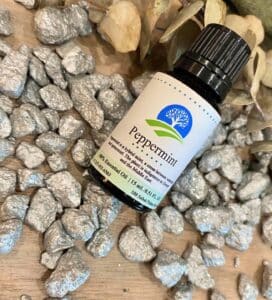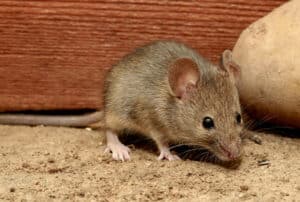Peppermint oil is known for its versatility as it comes in handy in different areas, from aromatherapy to skin care, digestive aid, muscle pain, and respiratory support. Also, you may have heard that peppermint oil for mice is an effective rodent repellent.
When mice invade your home, you can use peppermint oil to repel them away since they cannot stand its smell. This non-toxic, safe, natural substance will also deter insects like mosquitoes, spiders, and ants, giving you a bug-free home.
However, you may want to know if peppermint oil for mice is really an effective repellant. Read on to find out.
Does Peppermint Oil for Mice Really Work?
Yes, peppermint oil for mice works because of its strong smell which is unpleasant to them. Furthermore, the pungent smell can interfere with a mouse’s ability to smell food or navigate, making it hard for them to survive.
However, peppermint oil’s effectiveness in repelling mice can vary depending on various factors. These include the infestation severity, the specific mice species, and the environmental conditions. Moreover, it has limited effectiveness in repelling large mice infestations.
Related Posts:
Therefore, relying solely on peppermint oil is unlikely to completely solve the problem when dealing with a severe mouse infestation. Also, keep in mind that mice can be persistent and adaptable, so they can become accustomed to the scent over time or find alternative routes to access your home or food sources.
Moreover, while some mice may find the peppermint oil scent irritating or repellent, others may not be affected by it at all. If you’re considering using peppermint oil as a mouse deterrent, try it as part of a broader approach to mice control.
Combine it with other preventive measures, like ensuring your home stays clean, sealing gaps or holes, and using traps, for more effective results. Remember that a comprehensive approach that addresses factors such as food sources, shelter, and access points will yield better outcomes in managing and preventing mouse infestations.
How to Use Peppermint Oil for Mice
Peppermint oil may not be a foolproof solution against mice, but you can deter mice with it, provided you use it correctly.
Here’s how to do it
1. Purchase 100% Pure Peppermint Essential Oil
Therefore, look for well-known brands specializing in essential oils or those with a good reputation for producing high-quality products. Customer ratings and reviews help gauge the brand’s reliability.
In addition, check the peppermint oil bottle label to ensure 100% pure, undiluted, and free from additives, fillers, or synthetic fragrances. You should also look for information on the packaging or the brand’s website indicating that its products have undergone third-party testing for purity and quality.
If you prefer organic products, ensure the peppermint essential oil you get is certified organic. Also, ensure you buy from a reputable online or in-store seller.
2. Prepare The Peppermint Oil Repellent
You can use peppermint oil repellent in the form of spray or cotton balls. Let’s begin by preparing the spray.
Peppermint Oil Mouse Spray Repellent
Materials
- 100% pure peppermint essential oil
- Distilled water
- Spray bottle (preferably glass)
Instructions
a) Choose A Suitable Spray Bottle
Select a clean spray bottle for your repellent mixture. Glass bottles are better because they are less likely to interact with essential oils compared to plastic bottles.
b) Dilute The Peppermint Oil
Add water to the spray bottle but don’t fill it because you need enough space for the peppermint oil. Next, pour the peppermint oil in. Begin with a smaller amount, then slowly increase the quantity if needed. Use a funnel to avoid spillage.
Typically, you need around 10 to 15 drops of peppermint oil per 1 ounce (30 ml) of water. However, you can tweak the ratio based on the scent’s strength you desire.
c) Secure The Spray Bottle, Then mix The Contents
Close the spray bottle with peppermint oil solution, then it shake well to mix the water and essential oil thoroughly.
d) Test The Spray
Test the recipe on a tiny, inconspicuous spot prior to using it in sensitive areas or fabrics. Doing so ensures it doesn’t stain or damage your stuff.
Peppermint Oil Mouse Cotton Ball Repellent
Materials
- 100% pure peppermint essential oil
- Cotton pads or balls
- Small bowl or container.
i) Pour The Peppermint Oil Into The Container
Pour some pure peppermint oil into a small bowl or container.
ii) Soak The Cotton Balls Or Pads
Place the cotton balls or pads into the container with the peppermint oil, then gently press the cotton using a spoon or your fingers to ensure its soaks the oil. The cotton should be thoroughly saturated but not dripping excessively.
iii) Allow The Cotton Balls Or Pads To Absorb The Oil
Leave the cotton balls or pads inside the container for a couple of minutes to let them absorb the peppermint oil. This will enhance their scent and make them more effective.
3. Locate Entry Points And Problem Areas
You need to target the areas mice frequent when applying peppermint oil to increase its effectiveness, so identify these areas indoors and outdoors.
Find and seal any gaps or cracks mice may use to get into your house by inspecting the foundation, pipes, vents, utility lines, doors, siding, walls, and windows.
Mice will likely hide or shelter in crawl spaces, cabinets, attics, utility rooms, pipework, wiring, closets, and basements. Use a flashlight and mirror when inspecting hard-to-reach or tight places like behind appliances.
Also, look for mouse activity signs such as tracks, droppings, and gnaw marks.
4. Position the peppermint oil Mouse Treatment Strategically
After identifying the problem areas and entry points, spray or strategically position the peppermint oil cotton balls. Mice tend to travel along the edges of walls, so place the peppermint oil treatment near baseboards or along the paths where mice have been active.
Also, apply the peppermint oil treatment around entry points. These include gaps or cracks in walls, windows, doors, or utility penetrations to deter mice from entering.
Furthermore, if you have identified potential nesting spots, such as attics, basements, or hidden corners, position the treatment in or near these areas to discourage mice from nesting there.
Focus more on areas with concentrated mouse activity or places you suspect mice use to gain access into your home.
Additionally, expand your treatment to other places that may attract mice. These include kitchen cabinets, pantry shelves, and storage areas.
5. Refresh The Peppermint Oil Regularly
Peppermint oil can lose its scent over time, so refreshing the treatment is essential. Pay attention to the peppermint scent’s strength in the treated areas because the smell will weaken over time as the oil evaporates.
In addition, keep an eye on mouse activity in your home. Increased mouse activity or signs of mice returning to treated areas may indicate that the peppermint oil treatment needs refreshing.
Generally, refresh the peppermint oil treatment every 2 to 3 days or as needed based on the rate of scent dissipation and mouse activity.
Adjust the interval if the scent diminishes more rapidly to replenish the scent and maintain the repellent effect. If the cotton balls or pads dry out or lose their scent entirely, replace them with fresh ones. Concentrate the refreshed treatment in areas of high mouse activity, near entry points, or where you have observed signs of nesting or travel.
5. Monitor And Assess The Results
Monitoring and assessing the results of the peppermint oil treatment is crucial to determine its effectiveness in repelling mice. So,
Observe Mouse Activity
Look for signs like sightings, droppings, or chew marks. Note any changes in their behavior, such as avoidance of treated areas or a decrease in their presence.
Look For New Entry Points
Inspect your home regularly for any new potential entry points. If you discover new gaps, cracks, or openings, seal them promptly to prevent mice from entering.
Assess The Treatment’s Effectiveness
Evaluate how well the peppermint oil treatment is working. Consider factors such as the mouse sightings frequency, signs of activity, or damage caused by mice. This will help you gauge whether peppermint oil is effective in deterring the mice in your home.
How Long Does It Take Peppermint Oil To Get Rid Of Mice?
The time it takes for peppermint oil to get rid of mice can vary based on multiple factors. These include the infestation severity, the accessibility of food sources, the treatment’s effectiveness, the mice’s behavior, and the number of entry points.
However, peppermint oil for mice should work within a couple of days to a week, signified by reduced mouse activity. Nonetheless, remember that peppermint oil may not eliminate a mouse infestation on its own, and a comprehensive approach is often necessary.
Final Remarks
Using peppermint oil for mice as part of a comprehensive mice control strategy ensures these pesky rodents steer clear of your home. Peppermint oil alone may be able to repel mice for a short period, but they will eventually come back if you don’t adopt ways to achieve a long-term solution, such as sealing entry points.

I’m Mike Hyle, an exterminator with 7+ years of experience handling all sorts of pests, including mice, cockroaches, bed bugs, and termites. I also write for Pest Solutions DIY blog to share my knowledge and help homeowners keep their homes pest-free. Outside work, I enjoy hunting, snowshoeing, and exploring nature. Check out my blog for helpful pest control tips!


